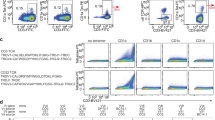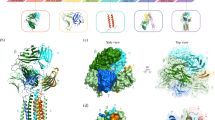Abstract
The precise molecular structure of the antigenic determinant recognized by the T-cell receptor of the CD4-positive cell has not been completely resolved. A major advance in our understanding of this issue has been made by our demonstration of a direct association between an immunogenic peptide and a purified Ia molecule1. The most likely and economical hypothesis is that antigen binds directly to an Ia molecule creating the antigenic determinant and that this antigen-Ia complex is recognized by the T-cell receptor. We examined in detail a determinant of hen egg-white lysozyme (HEL) contained in the tryptic fragment HEL(46–61), recognized by T cells in H-2k strains of mice2,3. This peptide binds with a Kd of ˜3 μM to I-Ak molecules1. We have already ascertained that (1) the 10-mer HEL(52–61) is the shortest stimulatory peptide4; (2) the Leu56 residue, the only residue different from mouse lysozyme, is responsible for the immunogenicity4; (3) the Leu56 and Tyr53 residues are critical for recognition by the T-cell receptor5 and (4) HEL(46–61) generates multiple determinants when it associated with the I-Ak molecule4,6. If antigen and Ia interact, the antigen must have two features: it must bind to an Ia molecule and also interact with the T-cell receptor7,8. The two sites do not appear to be laterally separable in this peptide5 and are therefore probably composed of distinct but interspersed amino-acid residues. We have now identified the three residues of HEL(52–61) that contact the T-cell receptor and three other residues that contact the I-Ak molecule. From modelling studies we also propose that HEL(52–61) assumes an α-helical conformation as it is bound to I-Ak and recognized by the T-cell receptor.
This is a preview of subscription content, access via your institution
Access options
Subscribe to this journal
Receive 51 print issues and online access
$199.00 per year
only $3.90 per issue
Buy this article
- Purchase on Springer Link
- Instant access to full article PDF
Prices may be subject to local taxes which are calculated during checkout
Similar content being viewed by others
References
1. Babbitt, B., Alien, P. M., Matsueda, G., Haber, E. & Unanue, E. R. Nature 317, 359–3(31 (1985).
2. Alien, P. M. & Unanue, E. R. /. Immun. 132, 1077–1079 (1984).
3. Alien, P. M., Strydom, D. J. & Unanue, E. R. Proc. natn. Acad. Sci. U.S.A. 81, 2489–2493 (1984).
4. Alien, P. M., Matsueda, G. R., Haber, E. & Unanue, E. R. J. Immun. 135, 368–373 (198?)).
5. Babbitt, B. P., Matsueda, G. R., Haber, E., Unanue, E. R. & Alien, P. M. Proc. natn. Acad. Sci. U.S.A. 83, 4509–4513 (1986).
6. Alien, P. M., McKean, D. J., Beck, B. N., Sheffield, J. & Glimcher, L. H. /. exp. Med. 162, 1264–1274 (1985).
7. Rosenthal, A. S. Immun. Rev. 40, 136–152 (1978).
8. Heber–Katz, E., Hansburg, D. & Schwartz, R. H. J. molec. cell. Immun. 1, 3–9 (1983).
9. Kronenberg, M., Siu, G., Hood, L. E. & Shastri, N. A. Rev. Immun. 4, 529–591 (1986).
10. Pincus, M. R., Gerewitz, F., Schwartz, R. H. & Scheraga, H. Proc. natn. Acad. Sci. U.S.A. 80, 3297–3301 (1983).
11. Spouge, J. L. et al. J. Immun. 138, 204–212 (1987).
12. Carbone, F. R., Fox, B. S., Schwartz, R. H. & Paterson, Y. /. Immun. 138,1838–1844 (1987).
13. Blake, C. C. et al. Nature 206, 757–760 (1965).
14. Buus, S., Sette, A., Colon, S. M., Jenis, D. M. & Grey, H. M. Cell 47, 1071–1077 (1986).
15. Hansburg, D., Heber–Katz, E., Fairvell, T. & Apella, T. J. exp. Med. 158, 25–39 (1983).
16. Watts, T. H., Gariepy, J., Schoolnik, G. K. & McConnell, H. M. Proc. natn. Acad. Sci. U.S.A. 82, 5480–5484 (1985).
17. Berkower, I. J., Buckenmeyer, G. K. & Berzofsky, J. A. J. Immun. 136, 2498–2503 (1986).
18. Guillet, J–G. et al. Science 235, 865–870 (1987).
19. Buus, S., Sette, A., Colon, S. M., Miles, C. & Grey, H. M. Science 235, 1353–1358 (1987)'.
20. Weiner, S. J., Kollman, P. A., Nguyen, D. T. & Case, D. A. J. comput. Chem. 7,230–252 (1986).
21. Nader, J. A. & Mead, R. Comp. J. 7, 308–313 (1965).
Author information
Authors and Affiliations
Rights and permissions
About this article
Cite this article
Allen, P., Matsueda, G., Evans, R. et al. Identification of the T-cell and Ia contact residues of a T-cell antigenic epitope. Nature 327, 713–715 (1987). https://doi.org/10.1038/327713a0
Received:
Accepted:
Issue Date:
DOI: https://doi.org/10.1038/327713a0
This article is cited by
-
Cancer immunotherapy: it’s time to better predict patients’ response
British Journal of Cancer (2021)
-
Evidence of genetic epistasis in autoimmune diabetes susceptibility revealed by mouse congenic sublines
Immunogenetics (2021)
-
An orthologous non-MHC locus in rats and mice is linked to CD4+ and CD8+ T-cell proportion
Genes & Immunity (2017)
-
RAFTsomes Containing Epitope-MHC-II Complexes Mediated CD4+ T Cell Activation and Antigen-Specific Immune Responses
Pharmaceutical Research (2013)
-
Interleukin‐10 limits the expansion of immunoregulatory CD4−CD8− T cells in autoimmune‐prone non‐obese diabetic mice
Immunology & Cell Biology (2010)
Comments
By submitting a comment you agree to abide by our Terms and Community Guidelines. If you find something abusive or that does not comply with our terms or guidelines please flag it as inappropriate.



